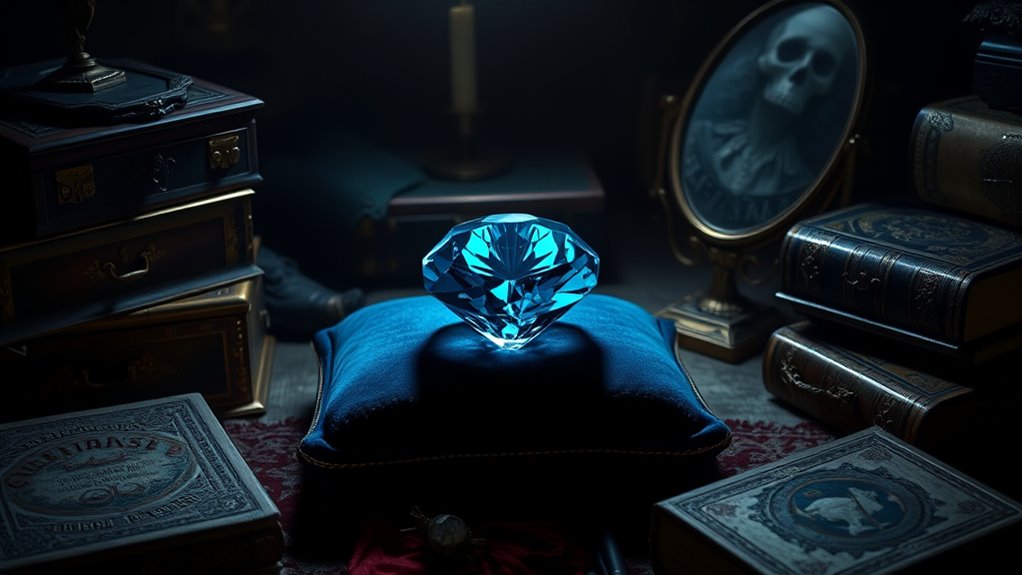The legend of a curse surrounding the Hope Diamond has fascinated many, but the truth is rooted in myth and superstition. Despite stories of tragedy and misfortune, there’s no scientific proof that the diamond causes bad luck. Many incidents are just coincidence or exaggerated over time. Humans tend to look for patterns and stories that capture the imagination. Want to uncover more about the real history behind this famous gem? Keep exploring to discover the facts.
Key Takeaways
- The legend suggests the Hope Diamond is cursed, but there’s no scientific evidence supporting this claim.
- Many misfortunes linked to owners are coincidental or exaggerated, not caused by the diamond itself.
- The myth of a curse gained popularity in the early 20th century, fueled by sensational storytelling.
- The diamond’s true value lies in its rarity, history, and striking appearance, not supposed supernatural influence.
- The curse is a myth; the diamond is an extraordinary artifact with a rich, factual history free of any real supernatural effects.

The Hope Diamond has long been shrouded in mystery and superstition, with many believing it carries a curse that brings misfortune to its owners. To truly understand the legend, you need to explore its gemstone history and separate myth from fact. The Hope Diamond’s story begins centuries ago in India, where it was originally known as the Tavernier Blue, named after the French gem merchant Jean-Baptiste Tavernier who sold it in the 17th century. Over the years, the stone changed hands multiple times, passing through royal collections and eventually becoming part of the French crown jewels. Its gemstone history is filled with tales of wealth and power, but also tragedy and loss, fueling the myth of a curse.
Many of these stories are exaggerated or rooted in superstition. The notion of a curse became popular in the early 20th century, especially after several owners experienced misfortune—deaths, financial ruin, or scandals. However, when you look at the facts, these incidents often occurred long after they acquired the diamond or were coincidental. The idea that a gemstone itself can curse someone is a myth that has persisted because of its dramatic appeal. In reality, gemstones like the Hope Diamond are natural mineral formations that have no consciousness or power to influence destiny.
Many stories are exaggerated; gemstones have no power to influence destiny.
Furthermore, the fascination with the diamond’s supposed curse is amplified by human psychology, which tends to seek patterns and assign meaning to random events. The tragedies associated with owners are more likely due to coincidence, misfortune, or the stresses of wealth and fame. The diamond’s legendary blue hue and size make it a enthralling object, but they also make it a fitting symbol for superstition. The story has been sensationalized over centuries, turning it into a legend that captures the imagination.
In truth, the Hope Diamond’s allure is based on its rarity, vibrant color, and storied gemstone history. Its reputation as a cursed object is a product of storytelling and human tendency to find meaning in tragedy. While many believe in curses as explanations for misfortune, you should see the Hope Diamond as a remarkable artifact—an extraordinary gemstone with a rich history—rather than a harbinger of doom. The myth persists because it’s a compelling tale, but the facts show that the stone’s dark reputation is just that: a myth, not a reality.
Frequently Asked Questions
Has Anyone Ever Truly Been Cursed by the Hope Diamond?
No, no one has truly been cursed by the Hope Diamond. While superstitious beliefs and cultural symbolism have fueled tales of misfortune, there’s no concrete evidence linking the diamond to curses. You might find stories intriguing, but they’re more rooted in legend than reality. It’s fascinating how such myths persist, but ultimately, the Hope Diamond’s reputation as cursed remains a enthralling myth rather than a verified fact.
What Are the Scientific Explanations for the Diamond’s Supposed Misfortunes?
You might wonder if the Hope Diamond’s supposed misfortunes have scientific explanations. Its geological origins trace back to ancient volcanic activity, forming over millions of years. Its mineral composition, primarily carbon, explains its brilliance and durability. These natural factors don’t cause curses but highlight the diamond’s rarity and beauty. Any stories of misfortune are just myths, as science shows the diamond’s history is rooted in Earth’s geological processes, not supernatural forces.
Are There Any Documented Cases of the Diamond’s Influence on Owners?
There are no documented cases that prove the Hope Diamond’s supernatural claims directly influence owners. Instead, you might experience psychological effects like anxiety or superstition, which could make you believe in its cursed reputation. These effects stem from the power of suggestion and cultural stories, not actual supernatural forces. So, while the legend persists, scientific evidence and documented incidents don’t support the idea that the diamond causes misfortune.
How Did the Hope Diamond Acquire Its Legendary Status Historically?
You might say the Hope Diamond’s legendary status was forged in the fires of history and culture. Its striking blue hue and mysterious past made it a symbol of fortune and misfortune, capturing imaginations worldwide. Over centuries, its association with royalty, tragedy, and intrigue transformed it into a cultural icon. This powerful symbolism cemented its place in history, turning a gemstone into a legend that continues to captivate us today.
What Are the Current Myths Versus Verified Facts About the Curse?
You might believe the superstition myths that the Hope Diamond curses its owners with misfortune, but historical legends suggest otherwise. Verified facts show no real evidence linking misfortune directly to the diamond, despite its dark reputation. Many stories are exaggerated or fabricated over time, making it clear that the curse is more a product of folklore than actual history. Focus on the gem’s fascinating history rather than the superstitions surrounding it.
Conclusion
As you hold the shimmering Hope Diamond in your mind, you can almost feel its icy weight pressing against your palm, whispering tales of curses and legends. Yet, beneath its sparkling surface lies a story shaped by myth and mystery, not misfortune. Remember, it’s just a beautiful gem, not a curse. Let its radiant glow remind you that sometimes, the stories we tell are more enthralling than the truth itself, waiting to be uncovered.










